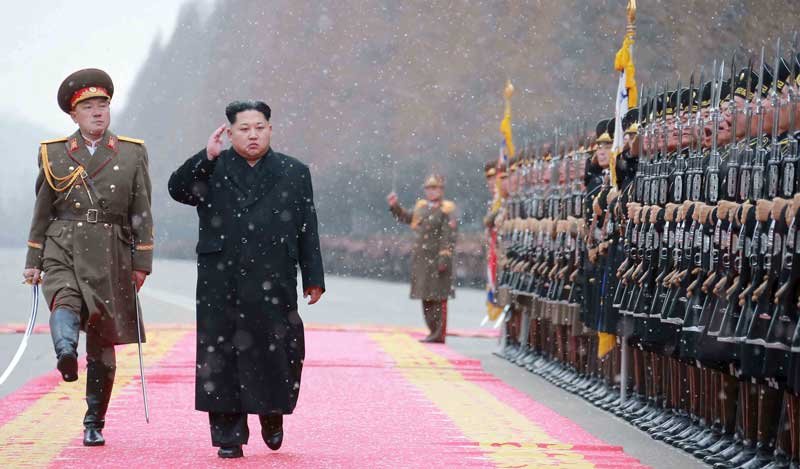The deployment of North Korean troops to fight in Russia’s war against Ukraine was one October surprise among many. November, December and the months thereafter will reveal how much Kim Jong Un’s forces can do to abet Vladimir Putin’s aggression. Yet the larger significance of the North Korean move may be what it reveals about the arsenal of autocracy taking shape.
The phrase “arsenal of democracy” was coined by Franklin Roosevelt during World War II. The thrust was that the US, not yet in the war, would arm and empower the friendly countries that were. Since February 2022, President Joe Biden has revived the concept in explaining America’s support for Ukraine. Yet the most striking, potentially historical advances toward deeper defense cooperation are coming from the autocratic side.
That integration is part of a broader phenomenon preoccupying the US government — the linking of arms by countries assaulting the international order. A “no limits” strategic partnership unites China and Russia, the two Eurasian giants. Iran and Russia have built what American officials call a “full-scale defense partnership.” Moscow and Pyongyang signed their treaty of alliance, which complements North Korea’s longstanding — if ambivalent — defense pact with China. Russia is helping a longtime Iranian client, Yemen’s Houthis, attack international shipping in the Red Sea.
Call it whatever you want — “axis of autocracies,” “axis of upheaval” or even “axis of losers” — but the reality is that the US faces a thickening web of alliance-like ties among its greatest foes. At the center of those relationships is collaboration in making and wielding the tools of war.
North Korea has provided millions of rounds of artillery to Putin’s forces, more than the US and its allies have given Kyiv. Iranian-made missiles and drones facilitate barrages against Ukrainian cities. Chinese factories have, reportedly, produced drones for Putin’s armies. Russia, in turn, has apparently agreed to provide its partners with more sophisticated aircraft and air defenses – among other capabilities – as part of a flourishing, autocratic arms trade that is changing the military balance in multiple regions.
Yet the revisionists aren’t simply trading in finished weapons; there is a deeper industrial integration underway. Tehran has built built factories that produce Iranian drones on Russian soil. China has undertaken a gigantic effort to rebuild Putin’s defense industrial base by selling him microchips, machine tools and other components. North Korean workers may already be toiling on Russian production lines.
More troubling, technology transfer is reaching new levels. Russia is reportedly aiding North Korea’s missile, satellite, and advanced weapons programs. Moscow and Beijing are engaging in joint development and co-production initiatives that grow more numerous, and more secretive, all the time.
Western governments are struggling to understand what, exactly, is happening in these partnerships, which raises the odds they will be surprised by the capability leaps that result. Perhaps North Korea’s next intercontinental missile, or China’s next attack submarine, will be more threatening thanks to the technology and know-how Putin is now trading away.
Finally, the autocracies are learning from one another. Iran’s missile and drone attack on Israel in April mimicked strikes that Moscow had carried out in Ukraine. Some of the value Kim gets from sending his soldiers into the Ukraine war will be the experience his army gains. And given that drones, missiles and missile defenses could shape the outcome of a US-China war in the Western Pacific, you can bet Beijing is studying the lessons of the Ukraine war.
Some perspective is necessary: Patterns of autocratic defense cooperation are still far less impressive than those that America and its closest allies enjoy. To this point, the best revenge for North Korea’s intervention in Ukraine would be if Washington can induce South Korea, which possesses huge quantities of 155mm artillery ammunition, to give more of it to Kyiv.
But military integration among the Eurasian autocracies is making the world’s most disruptive states better armed and better informed about the realities of modern war. Given that this integration has repeatedly surged ahead far faster than Western analysts predicted, expect these relationships to keep developing in surprising, destabilizing ways.
The emergence of this arsenal of autocracy is one of many reasons to cheer the devastating strikes Israel carried out against Iran last month. In destroying Iran’s advanced, Russian-made air defense systems, Israel revealed the limits of the kit Moscow can give its friends. In badly damaging Tehran’s missile production facilities, Israel probably helped Ukraine in addition to helping itself. Yet the same phenomenon reminds us how high the stakes in Ukraine really are —and how ominous the trajectory of that conflict is.
If Putin imposes a conqueror’s peace on Kyiv, it won’t simply be a tragedy for Ukraine. It will be a victory for the larger cohort of autocracies and a testament to what their cooperation can achieve in a test of strength against the West. The autocracies are pulling together, not least militarily, in what looks increasingly like a prewar era. The democracies will have to do so, as well.
